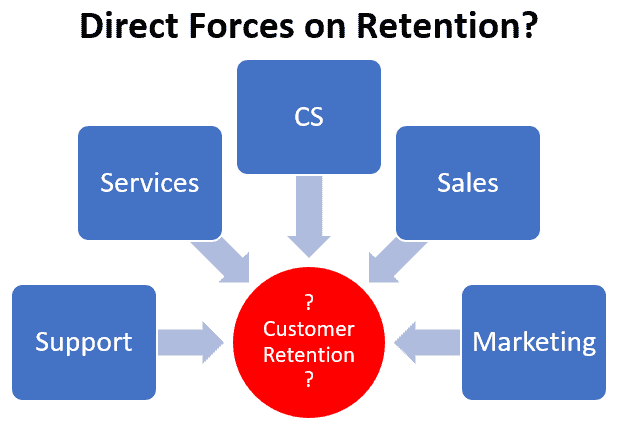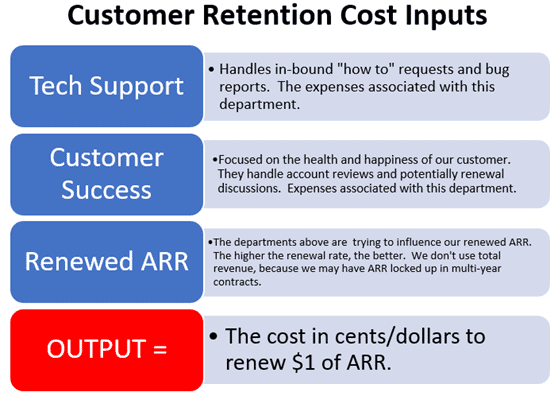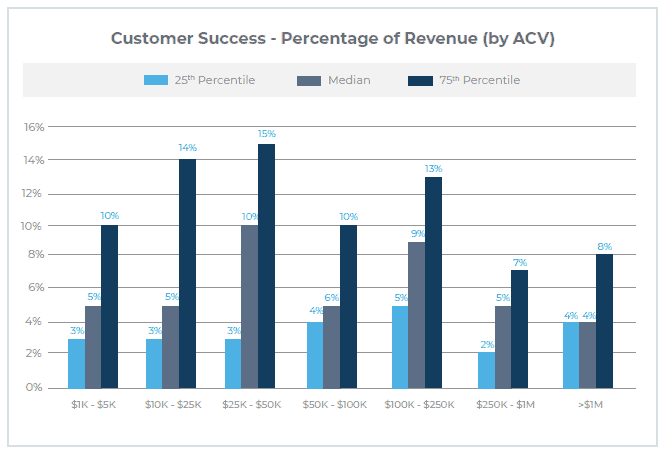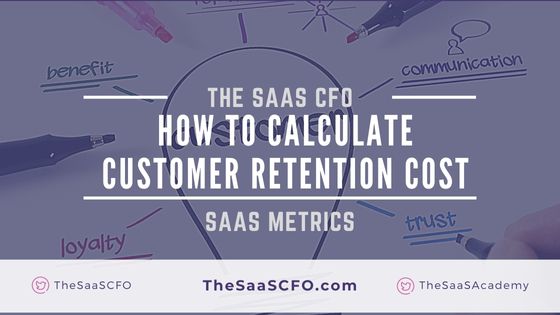The focus has shifted! Capital markets are tight. Economic conditions are unknown. New customer growth may be slowing down. Time to focus on customer retention and the health of our recurring revenue. What does it cost to retain a customer?
It’s somewhat ambiguous when we try quantify our customer retention costs. We know that we should focus on gross dollar retention and net dollar retention.

There are some posts on the Internet covering customer retention costs, but each posts says something a little different. Definitely no metrics standards here.
In this post, I will identify the forces in our SaaS company that have a direct impact on customers. Then, we’ll narrow this down to our customer retention costs. I’d argue that every department touches the customer but we will attempt to identify departments with regular interaction.
What is Customer Retention Cost
Customer retention cost focuses on the costs to retain your customers. No surprise here. But it’s a little ambiguous on what expenses and departments to include in customer retention costs. There are a lot of forces at play with retention.
This could be our product experience, onboarding, technical support, the sales experience, and so on. Doing some quick Internet research (no ChatGPT here), the expenses below seem to be a common thread. However, some posts appear to have simply copied and pasted their expense list from another list on the Internet.
- Professional services and onboarding
- Customer support
- Customer success
- Account management
- Loyalty programs
- Content marketing
- Software/tools involved in customer support
Let’s start from scratch. I identified the major functional areas below that interact with customers. Of course, folks in product, accounting, etc. also talk to customers, but I’m narrowing this list to consistent, major interactions.
- Technical Support
- Professional Services
- Customer Success
- New Business Sales
- Account Management
- Marketing
Now, let’s further refine this list to departments whose job it is to support existing customers on an on-going basis.
- Technical Support
- Customer Success
- Account Management
- Marketing
How to Calculate Customer Retention Costs
For metrics to have value in our business, they must be repeatable each month. The input data must also be accurate and simple.
I’ll start with a basic customer retention cost formula. The first iteration will use just expense inputs from technical support and customer success.
We also need our renewed ARR. I’m not going use total revenue, because we could have revenue tied up in multi-year contracts. They must renew until the contract expires.

We can calculate the cost of retention on a dollar basis. The formula below results in the cost in cents/dollars to renew one dollar of ARR. This is a similar concept to the Cost of ARR.

We can also calculate customer retention costs on a unit basis. In this case, the cost to renew the average customer.

What about account management and marketing? I’d make the case that some portion of these departments’ expense could be included in the formula. Again, there are not standards yet for this formula.
How Much Should We Spend in Customer Success?
There are some great benchmarks out there, but they are often overlooked. I’d like to highlight the customer success benchmark report produced by RevOpsSquared.com and Gainsight. You can find the report at this link.
This first chart indicates the amount spend in the customer success department as a percentage of revenue. Great overall reference for planning purposes.

The next chart is how I like to benchmark SaaS companies. I segment the benchmarks by product ACV. SaaS companies’ profiles and expectations are much different when you are selling a $100 product versus a $100,000 product.
The chart below provides a goal post for your company’s investment (or lack of investment) in customer success.

Using Data to Predict Customer Retention
Of course, it’s not just financial data at play here. More and more SaaS companies are tracking customer behavior in their applications. This is producing a ton of data for analysis.
Once you have collected (and continue to collect) data on customer behavior, it is important to analyze the patterns and trends. This will potentially help you understand the customer segments and/or ideal customer profiles (ICP) that have the most success in your platform. More success, better retention.
This is another great chart from the Gainsight study. It lists the popular metrics being used to track and predict customer behavior and retention.

Takeaways
Customer retention costs are still an ambiguous expense in SaaS companies. There are so many forces that impact customer retention.
The goal of this post is to help you think through the direct forces at play in your company. Do you have a customer success team? A customer support team? Do you have dedicated initiatives focused on the health of your recurring revenue.
The data shows that it’s much more efficient to expand our existing customer base than it is to acquire new customers.
I have worked in finance and accounting for 25+ years. I’ve been a SaaS CFO for 9+ years and began my career in the FP&A function. I hold an active Tennessee CPA license and earned my undergraduate degree from the University of Colorado at Boulder and MBA from the University of Iowa. I offer coaching, fractional CFO services, and SaaS finance courses.

Hi Ben, good content as always. I think you have your CRC formulas transposed.